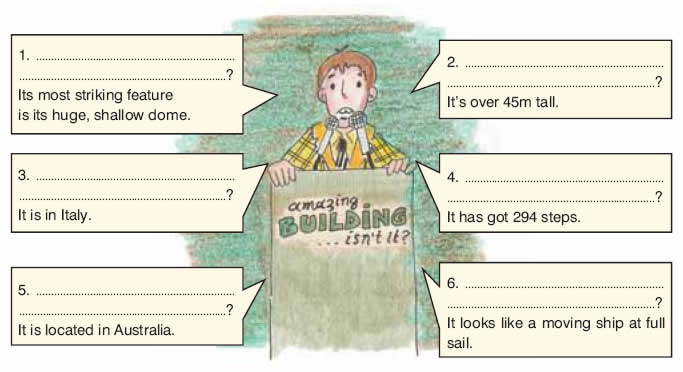LESSON 3 • DIFFERENT PLACES - DIFFERENT BUILDINGS
UNIT 1
|
LESSON 3 • DIFFERENT PLACES - DIFFERENT BUILDINGS
 UNIT 1
|
LESSON 3 • DIFFERENT PLACES - DIFFERENT BUILDINGS

The comparative is used .......................................................................................
The superlative is used ..........................................................................................
UNIT 1
|
LESSON 3 • DIFFERENT PLACES - DIFFERENT BUILDINGS

You have decided to enter a creative writing competition. The title of the competition entry is the
following: “Every Building has its own Story”. Look at the building in the picture and write its story. The following questions will help you.
UNIT 1
|
LESSON 3 • DIFFERENT PLACES - DIFFERENT BUILDINGS
has decided to make a presentation on different countries, focusing on Houses, Food and Clothes. Work in groups. Choose the country you want to present and research the following areas: Find information about different types of houses around the world, e.g. a Dyak longhouse
in Borneo, a house with murals in Germany or India, a houseboat on the canals of Amsterdam in Holland or along the river Rio Negro in Brazil, a tent of the wandering people called Bedouin or the people of Mongolia, etc. Find out what other people eat or drink in their country, e.g. ‘tortillas’ in Central and South America, ‘chapattis’ in India, reindeer milk in Lapland, camel milk in Saudi Arabia, raw fish and seaweed in Japan, etc. Find information about unusual clothes, e.g. parkas in Alaska, dishdashas in Dubai, kilts in Scotland or kimonos in Japan, etc.
UNIT 1
|
SELF-ASSESSMENT
UNIT 1
|
SELF-ASSESSMENT
 Work by yourself and tick the sentences that are true for you. You can discuss your answers in class. Working with Vocabulary 1. When I read or hear a word I don’t understand,
2. To help myself remember words
In Lessons 1, 2, and 3 you learnt a lot of new vocabulary. Do you remember it? Do you need to spend Reflecting on your Learning Tick the sentences that are true for you.
UNIT 1
|